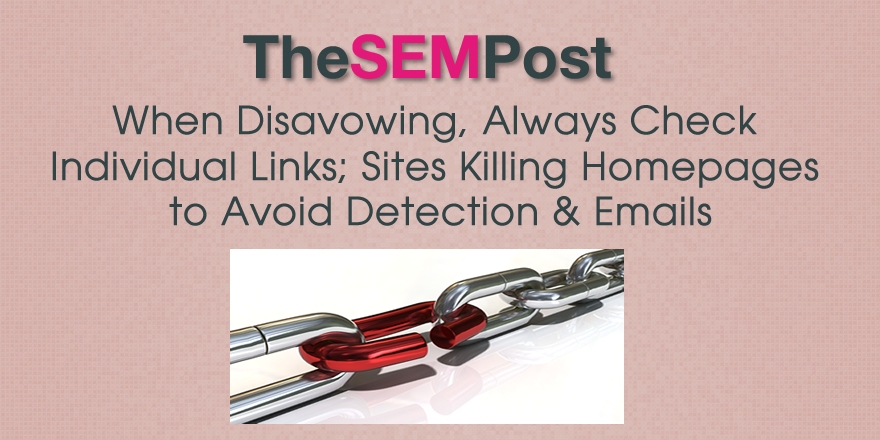 If you are doing link audits for clients affected by either penguin or with unnatural link warnings, if you find a dead homepage, don’t assume the entire site is dead.
If you are doing link audits for clients affected by either penguin or with unnatural link warnings, if you find a dead homepage, don’t assume the entire site is dead.
When doing link audits, some people just check the homepage of the site a link is coming from, rather than checking the page itself. But if you discover a dead domain, instead of assuming the entire site is dead, it is more likely the site is simply killing the homepage to prevent the onslaught of removal emails and to avoid being disavowed.
Sha Menz from rmoov, a link removal service for publishers, was the first to notice the pattern of dead homepages emerging, and tweeted it.
Seeing huge increase in number of spammy domains killing home page to make sites appear dead. Check specific URLs!!
— rmoov (@rmoov) June 5, 2015
“What is particularly interesting of late is the rapid increase in this tactic of parking the www subdomain and the addition of deliberately “killing” the home page at the root so it appears the site is completely down,” says Menz. “In recent link audits we have noticed these tactics appearing in an average of 1 in 5 domains checked. Such an increase in a short period (during the first half of this year) suggests perhaps there are people advocating these tactics as a way of avoiding link removal email.”
She also noticed that webmasters were moving content to new subdomains in order to kill the homepage as well. “It seems these webmasters are spending a lot of time and energy (and making unhelpful changes to their own sites) just to avoid receiving email from people trying to get links removed,” says Menz. “The pity of this is that there is a much simpler and less stressful solution which provides both the webmaster and those trying to contact them, with everything they need.”
This isn’t an entirely new problem, although it used to be much more uncommon. “In the early days of Penguin and mass manual actions, we would occasionally see sites where the www subdomain was parked while other subdomains continued to exist and function as normal,” says Menz. “In such cases a check of the home page would suggest the domain no longer contained content other than the ‘parked domain’ format.”
She stresses the importance of ensuring you check individual URLs when conducting link audits. “A check of specific URLs on the other hand, would show that there were subdomains with links still live. There were also other, less sophisticated tactics employed to try to make it appear that entire domains were dead. These included 302 redirects to fake 404 pages and pages with content pushed far enough down to make the home page appear blank.”
Always ensure that you, or whoever is doing your link audits, always check the exact URL and not just the homepage.
Jennifer Slegg
Latest posts by Jennifer Slegg (see all)
- 2022 Update for Google Quality Rater Guidelines – Big YMYL Updates - August 1, 2022
- Google Quality Rater Guidelines: The Low Quality 2021 Update - October 19, 2021
- Rethinking Affiliate Sites With Google’s Product Review Update - April 23, 2021
- New Google Quality Rater Guidelines, Update Adds Emphasis on Needs Met - October 16, 2020
- Google Updates Experiment Statistics for Quality Raters - October 6, 2020
Tom says
I dont really see what is in it for them though? Why would they want to remove the homepage but keep spammy pages active just to prevent link removal emails? Surely if they wanted to prevent those emails they’d just take the whole site down? I think this 1 in 5 stat is incredibly overinflated. It may be the case for one link audit, when the site owner had paid one person to put spammy links up on a particular link network, but I cannot see this being a pervasive tactic.
Max Peters says
Seems a bit strange people only check the home page, surely you check the actual age the link is on no?
Jennifer Slegg says
I do, but apparently not everyone does, especially if they have a ton of links from one site… they go to the homepage to get an impression of the site, see it’s dead and go on to the next site.